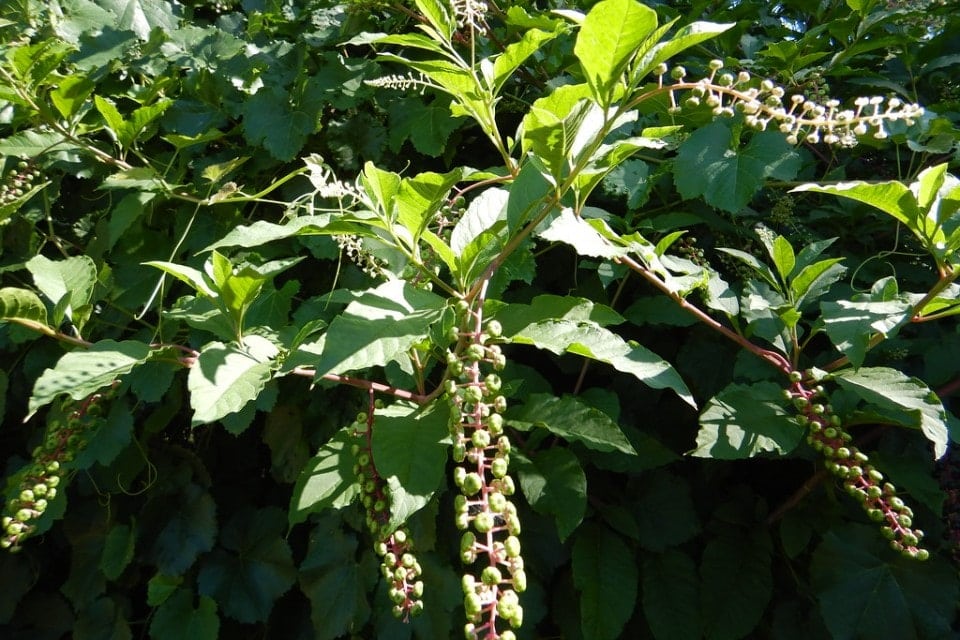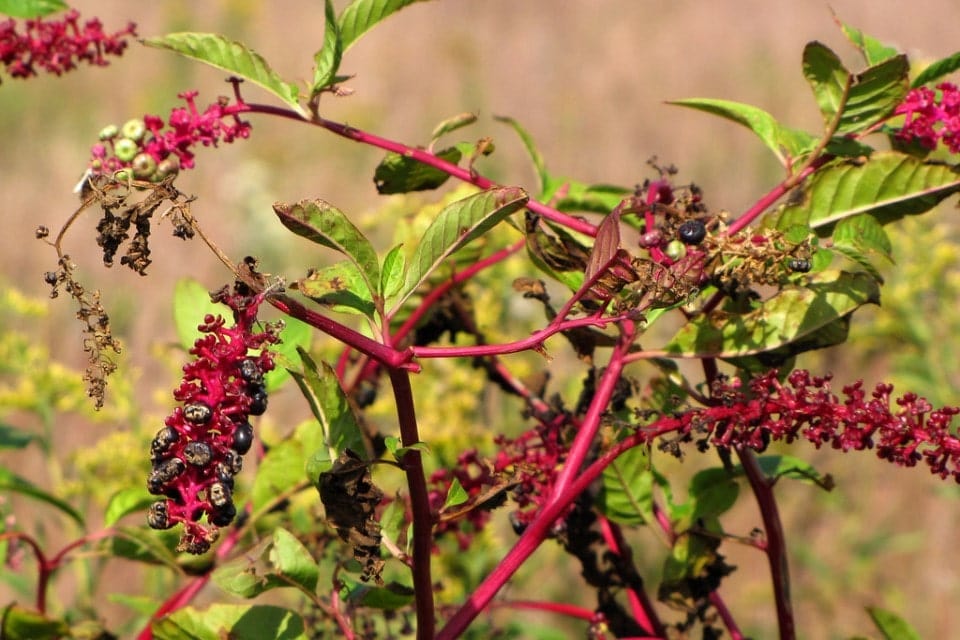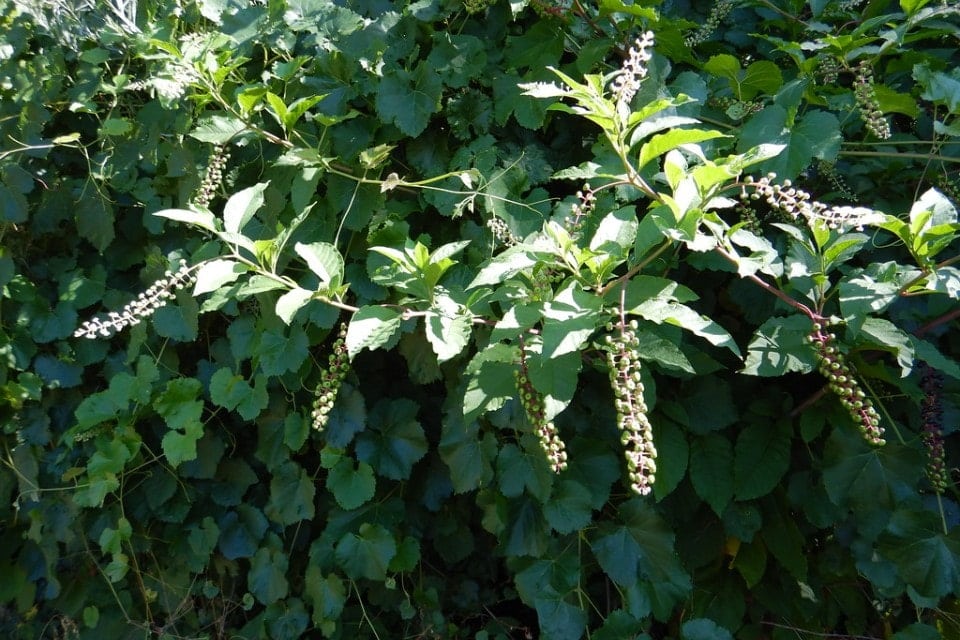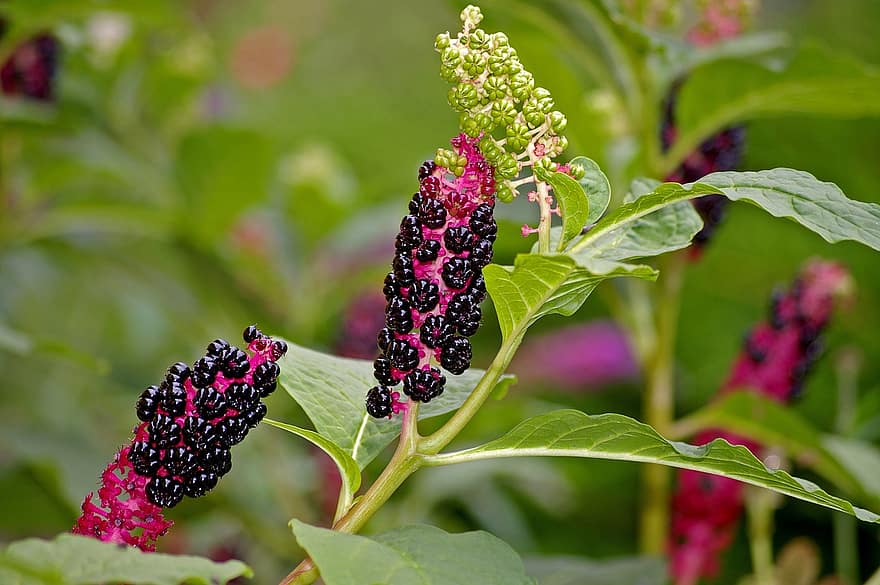How To Get Rid Of Pokeweed In My Garden
Home » Gardening » How to Get Rid of Pokeweed: Top Tips and Step-by-Step Guidance
How to Get Rid of Pokeweed: Top Tips and Step-by-Step Guidance
![]()
Pokeweed, usually referred to as pokeberry, is known and widely used in America since ancient times. Native Americans used it in medical issues, while inhabitants of South territories even added it into the food.
Although the plant looks nice and appealing with multiple blackberries and juicy green leaves, many people wonder how to get rid of pokeweed mainly because of its poison. Even if you use the pokeweed, you may want to limit the amount of this plant in your yard.
Usually, pokeweed removal does not take much time; however, you need to act extremely carefully. Its berries and leaves contain poison and may cause allergies or various toxic reactions. Leaving them to grow in your garden is getting even more dangerous in case you have children running around the house. Berries can attract them by similarity with numerous eatable fruits. If you have pets, they may also get poisoned by this plant.
I am going to help you with these simple tips on how to remove pokeweed from your yard. Follow my recommendations, and don't forget to wear protective clothing. If you have your own stories to share, you can do this in the comments below.
Buyer's Guide and Supplies

Before I share my tips with you, let's talk more about pokeweed. How well are you familiarized with this plant? Can you identify it from others? Not all experienced gardeners can do it so easily.
What is pokeweed?
Pokeweed or pokeberries, or dragon berries is a dangerous poisonous plant. Its scientific name is Phytolacca Americana. While scientists believe that the average plant can grow high up to 8 feet, many gardeners swear that they have 10 feet long pokeweed in their yard. This plant is native for the North America region but can be met in the Midwest and West as well. Dragonberries also grow in Europe and Asia.
The berries are dark purple, almost black, and are located tightly to each other. The leaves are pale or juicy green and wide. The flowers that appear before the berries on the plant are a mix of white and green, narrow, up to 8 inches long. Usually, each flower has 5 petals. Beware! This weed with purple berries may remind you of grapes.
Is this plant dangerous?

Yes, it is. Pokeberries can be easily mistaken for grapes. The berries look really similar. But while eating grapes can only fill your stomach, eating pokeberries can make your suffocate, threw up, or even die. The younger the child, the more actively pokeberries poison the body.
The most poisonous is still its roots. Then come stems and leaves, which both have the same intermediate level of toxicity. The least toxic are berries, which are exposed to children and animals the most.
Pokeberries are usually eaten by birds. They don't require much, and this is why they don't get poisoned. Pokeweed attracts brown thrashers, mockingbirds, catbirds, and northern cardinals. Small animals who are immune to the toxins of the berries can also feed on this plant.
However, it happens rarely. Usually, people and animals that eat these juicy dark purple or blackberries can die. Not only berries are poisonous, so you can't touch leaves and stems with bare hands.
Symptoms of poisoning are:
- Salivation;
- Burning feeling in the mouth;
- Bloody diarrhea;
- Vomiting;
- Gastrointestinal cramps.
How To Get Rid of Pokeweed in Your Garden: Preparations

The first thing goes first, and if you want to start poke weed eradication, you have to prepare for it carefully. The plant is dangerous from the berries to its root. Here are the tools I use personally.
Removing pokeweed in garden gloves

I use leather gardening gloves by FirTree Brand. They are durable and protect my skin up to the elbows. I do not recommend you to use any cheap fabric when you touch pokeweed to avoid poisoning. These gloves are affordable and made specifically for gardeners. I can easily take care of my rose garden without getting scratched by thorns. Besides, they are light and breathable comparing to synthetic ones. Needless to say, they are more pleasant for the skin, especially if you work for many hours.
Shovel
I can't imagine how to get rid of pokeweed safely without a proper shovel. The root of this plant is not something you can extract so easily with your hands. A shovel by Stanley Garden is only 26.5 inches long. It has a fiberglass handle with a non-slippery grip and a shovel blade made from high-quality metal with powder coating. The handle is 18.5 inches long, and the blade is 8 inches. As you may have already noticed, the shovel is not big, and this is why I consider it a helpful tool. It is not heavy, and you can take this shovel for camping with you.
Wheelbarrow
When the killing pokeweed procedure is over, and you dig out all the poisonous plants in your yard, you have to get rid of it for good. Don't leave it on the same spot. I have been using the wheelbarrow by Gorilla Carts for many years already. I picked it for its reliable massive wheels of 10 inches and poly bed with a rustproof coating of 38.7 x 20 inches. Besides, I don't like to go back and forth while I am removing weeds. This wheelbarrow allows me to carry all of them at once. Developers say this wheelbarrow can pull up to 66 pounds, which I believe I have checked not once but multiple times.
Glyphosate Concentrate Pokeweed Herbicide
The weed killer by Compare-N-Save is the one I recommend the most, and not only because it is affordable and savvy, but mainly because it kills all the weeds I need. It is offered in a 1-gallon pack. You can see the results in 2-4 days. Once you spread it, check every day. This product contains 41 percent glyphosate, and 1 pack can cover 25 000 square feet, so it will serve you and your garden for a long time. The spray is already ready for use, don't add anything in it.
Additional items you will need while dealing with pokeweed:
- Water or brush. Water is an essential and helpful solution while pulling or digging the roots from the ground. Using the soil screen may be a big help when it comes to getting rid of pokeweed. As you already know, this plant has a tricky root system, and you have to find out whether you dug up the whole root.
Spray root with water or use the brush to get rid of the dirt. The brush may be messier than water, as it will spread the particles of soil around. Be careful with the water from the root, as it is also poisonous. Don't leave it on the ground. I recommend placing the screen on your wheelbarrow before cleaning out the root; - Garbage Bag is the tool you need to dispose of already dried pokeweed. Do not throw away the freshly dug out plant. It will grow in the other place where you will throw it. Before you put it into the garbage bag, make sure it is dried out completely;
- Protective clothes. Wear clothes that will be long enough to protect your arms, legs, and the whole body. Having a shirt with long sleeves may save you from the poison of pokeweed. Besides, you will always be protected from the sun.
- Protective glasses. Don't forget to use the glasses while you are spraying the weed killer. I also wear glasses any time I use a shovel in the garden. I want to protect my eyes from the soil. You may require them for various procedures in your yard. So, this is a must-have for everyone who decided to grow a garden;
- The herbicide is another measure. If pokeweed still arises in your yard every spring, don't worry, you can deal with it by using herbicide. It is toxic to the plant. You will need to use herbicide mixed with water and sprayed onto the stems several times. After 2 days, you can remove stems, and after 10 days, you can dig up the plant with the root.
Step-by-Step Guide
This is a brief guide of your actions. Prepare everything from the preparation list, as it is essential to wear protective gloves and cover your hands and legs from touching the pokeweed. Remember that even the root is toxic.
🌱 Step 1. Pull out young shoots manually
It does not take much time to see the newly appeared plants. They are still weak, and you can easily pull them out. You have to do it first, as they are the easiest to pull and after that, you will be able to observe the territory. Don't forget to check out whether you have moved the whole taproot. To remove it, grasp the stem close to the root and pull it the same way you would pull the carrot out.
🌱 Step 2. Getting rid of pokeweed
Now you can use the weed killer for the rest of the pokeweed. Prepare to wait several days until you see that all the plants you've sprayed are dead. Depending on the territory, you may wait up to 4 days. But I can easily remove dead pokeweed in 1 day. Spraying the weed killer, put on not only the gloves but also protective glasses and a mask for your nose.
🌱 Step 3. Loosen the soil
Don't leave the place bare after you remove the pokeweed. You need to make sure that you dug up all the plants, and nothing is left in the soil. Take the shovel and loosen the ground. The small pieces of root that will be left in the ground can regrow again. Check out the soil where the root was. Dig at least 12 inches deep. Rake soil a few times.
🌱 Step 4. Dispose of the pokeweed
Don't leave the pokeweed lay on the soil. Remember that this plant is poisonous. You can't hold it on your territory and expect that you and your family will be safe. You have to get rid of the plant. While there are numerous tips on how to kill pokeweed, not many gardeners worry about how to dispose of it.
I recommend performing the next steps:
- Gather all the pokeweed and carry it somewhere far from children and animals;
- Lay it on the fabric, so it wouldn't touch the ground and wouldn't be able to grow. The place must be under the direct sun;
- Wait until the plant dries out completely;
- Take the waste bin for green materials and carefully put all the dried parts of the plant there.
Don't place the fresh pokeweed in the waste bin, as it may grow in the composting center of your community center. Don't forget to perform all these actions in protective gloves. If you use herbicide, remember to cover your nose and eyes as well to avoid the irritation.
🌱 Step 5. Monitor the soil
Killing the pokeweed plant is not the simplest thing to do. Roots are tricky and can lay hidden from you in the soil even after you think you get rid of all the pieces of the plant. The more you are loosening the soil and raking through it, the fewer chances you give to these toxic poke berries to grow again.
However, even with the best and the most powerful herbicide that contains glyphosate, you can miss tiny areas of soil. Young plants are easier to remove and kill than completely grown. Check out the territory for up to 10 days. I don't recommend you to plant anything there before the deadline.
Popular Questions About Pokeweed

If you have not received the answers on your questions yet, you may find them in this section. Here, I gathered the most popular questions I see on the Internet. Check them out; you may find them useful.
Can you burn pokeweed?
Many gardeners burn American pokeweed when it is completely dried out. Burning the fresh pokeweed can be extremely dangerous and poisonous. I don't recommend you to burn it at all. Instead, you have to dry it out on the sun, carefully pack in the bag and throw it into the disposal.
Is pokeweed poisonous to touch?
We have already discussed what is pokeweed and how dangerous are the leaves, stems, roots, and berries. Even a touch can affect you, cause skin irritation, suffocation, and poisoning. You can't touch the plant, especially if there are large amounts of it.
Can you eat pokeberry?
Native Americans ate the boiled root. In some regions of Asia, people add berries into wine and vinegar to color it. Inhabitants of South America used to add berries into pies. However, without proper preparations or with different body sensitivity, you can get poisoned in no time and die. Don't risk your health.
Will vinegar kill pokeweed?
Vinegar is naturally made acid, so it burns the roots of pokeweed. If the root is still not strong enough, distilled vinegar may be the solution you are looking for. Mix vinegar and water in 50/50 proportion and spray it on every pokeweed. However, this measure is not that effective as a weed killer and may not work on strong old roots.
Does Roundup kill pokeweed?
Definitely yes. Roundup kills anything that is herbaceous. This also means that you have to be extremely careful. If common pokeweed grows somewhere near other plants, Roundup will kill these plants as well. I don't recommend you to use Roundup in your garden, mainly because of the harm for other plants, but you can spray it on pokeweed if it is growing far from flowers or crops.
Is pokeweed good for anything?
For many centuries pokeweed was used as a medical treatment for Native Americans, and food indigenous to western hemisphere. They treated anxiety, epilepsy, and neurological disorders. I can say for sure whether it was helpful or not. Scientists still research the qualities of pokeweed. They believe its proteins may help to treat some types of cancer.
The Importance of Getting Rid of Pokeweed
Pokeweed may look beautiful and attractive, but you can't consider it safe for you or your children. I have gathered the most helpful tips for you here, based on my personal experience. Being a gardener means you have to take care of all the plants that are growing in your garden. Once you notice pokeweed, it is better to get rid of it immediately, so no humans or animals could get harmed. I am wondering whether you had previous experience with pokeweed. How did you get rid of it? Share your story in the comments below.
Post Views: 10,985
Last update on 2021-12-04. The post includes Affiliate links. Images from Amazon Product Advertising API
How To Get Rid Of Pokeweed In My Garden
Source: https://bumpercroptimes.com/how-to-get-rid-of-pokeweed/
Posted by: martinhambsood.blogspot.com

0 Response to "How To Get Rid Of Pokeweed In My Garden"
Post a Comment